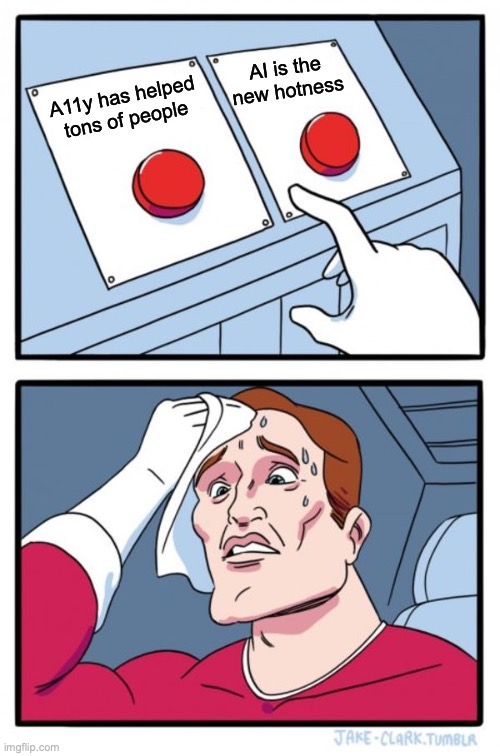AI is not magic, part 1033: Accessibility
You know it's a good sign when the first thing I do after finishing an article is double-check whether the whole site is some sort of AI-generated spoof. The answer on this one was closer than you might like, but I do think it's genuine.
Jakob Nielsen, UX expert, has apparently gone and swallowed the AI hype by unhinging his jaw, if the overall subjects of his Substack are to be believed. And that's fine, people can have hobbies, but the man's opinions are now coming after one of my passions, accessibility, and that cannot stand.
Very broadly, Nielsen says that digital accessibility is a failure, and we should just wait for AI to solve everything.
This gif pretty much sums up my thoughts after a first, second and third re-read.
 I got mad at literally the first actual sentence:
I got mad at literally the first actual sentence:
Accessibility has failed as a way to make computers usable for disabled users.
Nielsen's rubric is an undefined "high productivity when performing tasks" and whether the design is "pleasant" or "enjoyable" to use. He then states, without any evidence whatsoever, that the accessibility movement has been a failure.
Accessibility has not failed disabled users, it has enabled tens of millions of people to access content, services and applications they otherwise would not have. To say it is has failed is to not even make perfect the enemy of the good; it's to ignore all progress whatsoever.
 I will be the first to stand in line to shout that we should be doing better; I am all for interfaces and technologies that help make content more accessible to more people. But this way of thinking skips over the array of accessible technology and innovations that have been developed that have made computers easier, faster and pleasant to use.
I will be the first to stand in line to shout that we should be doing better; I am all for interfaces and technologies that help make content more accessible to more people. But this way of thinking skips over the array of accessible technology and innovations that have been developed that have made computers easier, faster and pleasant to use.
For a very easy example, look at audio description for video. Content that would have been completely inaccessible to someone with visual impairments (video with dialogue) can now be understood through the presentation of the same information in a different medium.
Or what about those with audio processing differences? They can use a similar technology (subtitles) to have the words that are being spoken aloud present on the video, so they more easily follow along.
There are literally hundreds, if not thousands of such ideas (small and large) that already exist and are making digital interfaces more accessible. Accessibility is by no means perfect, but it has succeeded already for untold millions of users.
The excuse
Nielsen tells us there are two reasons accessibility has failed: It's expensive, and it's doomed to create a substandard user experience. We'll just tackle the first part for now, as the second part is basically just a strawman to set up his AI evangelism.
Accessibility is too expensive for most companies to be able to afford everything that’s needed with the current, clumsy implementation.
This line of reasoning is absolute nonsense. For starters, this assumes that accessibility is something separate from the actual product or design itself. It's sort of like saying building a nav menu is too expensive for a company to afford - it's a feature of the product. If you don't have it, you don't have a product.
Now, it is true that remediating accessibility issues in existing products can be expensive, but the problem there is not the expense or difficulty in making accessible products, it's that it wasn't baked into the design before you started.
It's much more expensive to retrofit a building for earthquake safety after it's built, but we still require that skyscrapers built in California not wiggle too much. And if the builders complain about the expense, the proper response is, "Then don't build it."
If you take an accessible-first approach (much like mobile-first design), your costs are not appreciably larger than ignoring it outright. And considering it's a legal requirement for almost any public-facing entity in the US, Canada or EU, it is quite literally the cost of doing business.
A detour on alt text
As an aside, the above image is a good example of the difference between the usability approach and the accessibility approach to supporting disabled users. Many accessibility advocates would insist on an ALT text for the image, saying something like: “A stylized graphic with a bear in the center wearing a ranger hat. Above the bear, in large, rugged lettering, is the phrase "MAKE IT EASY." The background depicts a forest with several pine trees and a textured, vintage-looking sky. The artwork has a retro feel, reminiscent of mid-century national park posters, and uses a limited color palette consisting of shades of green, brown, orange, and white.” (This is the text I got from ChatGPT when I asked it to write an ALT text for this image.)
On the other hand, I don’t want to slow down a blind user with a screen reader blabbering through that word salad. Yes, I could — and should — edit ChatGPT’s ALT text to be shorter, but even after editing, a description of the appearance of an illustration won’t be useful for task performance. I prefer to stick with the caption that says I made a poster with the UX slogan “Keep It Simple.”
The point of alt text is to provide a written description of visual indicators. It does NOT require you to describe in painstaking detail all of the visual information of the image in question. It DOES require you to convey the same idea or feeling you were getting across with the image.
If, in the above case, all that is required is the slogan, then you should not include the image on the page. You are explicitly saying that it is unimportant. My version of the alt text would be, "A stylized woodcut of a bear in a ranger hat evoking National Park posters sits over top of text reading "Make it easy.""
Sorry your AI sucks at generating alt text. Maybe you shouldn't rely on it for accessibility because it true accessibility requires ascertaining intent and including context?
The easy fix
Lolz, no.
The "solution" Nielsen proposes should be no surprise: Just let AI do everything! Literally, in this case, he means "have the AI generate an entire user experience every time a user accesses your app," an ability he thinks is no more than five years away. You know, just like how for the past 8 years full level 5 automated driving is no more than 2-3 years away.
Basically, the AI is given full access to your "data and features" and then cobbles together an interface for you. You as the designer get to choose "the rules and heuristics" the AI will apply, but other than that you're out of luck.
This, to be frank, sounds terrible? The reason we have designers is to present information in a coherent and logical flow with a presentation that's pleasing to the eye.
The first step is the AI will be ... inferring? Guessing? Prompting you with a multiple choice quiz? Reading a preset list of disabilities that will be available to every "website" you visit?
It will then take that magic and somehow customize the layout to benefit you. Oddly, the two biggest issues that Nielsen writes about are font sizes and reading level; the first of which is already controllable in basically every text-based context (web, phone, computer), and the second of which requires corporations to take on faith that the AI can rewrite their content completely while maintaining any and all style and legal requirements. Not what I'd bet my company on, but sure.
But my biggest complaint about all of this is it fails the very thing Nielsen is claiming to solve: It's almost certainly going to be a "substandard user experience!" Because it won't be cohesive, there have literally been no thought into how it's presented to me. We as a collective internet society got fed up with social media filter bubbles after about 5 years of prolonged use, and now everything I interact with is going to try to be intensely personalized?
Note how we just flat-out ignore any privacy concerns. I'm sure AI will fix it!
I really don't hate AI
AI is moderately useful in some things, in specific cases, where humans can check the quality of its work. As I've noted previously, right now we have not come up with a single domain where AI seems to hit 100% of its quality markers.
But nobody's managed to push past that last 10% in any domain. It always requires a human touch to get it "right."
Maybe AI really will solve all of society's ills in one fell swoop. But instead of trying to pivot our entire society around that one (unlikely) possibility, how about we actually work to make things better now?
"I always love quoting myself." - Kait
